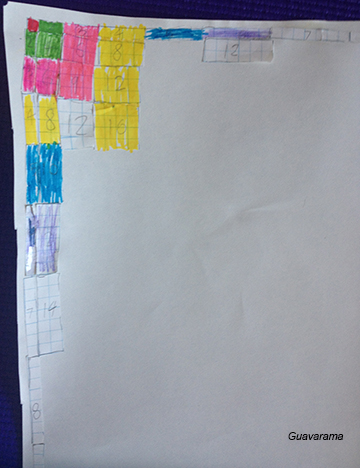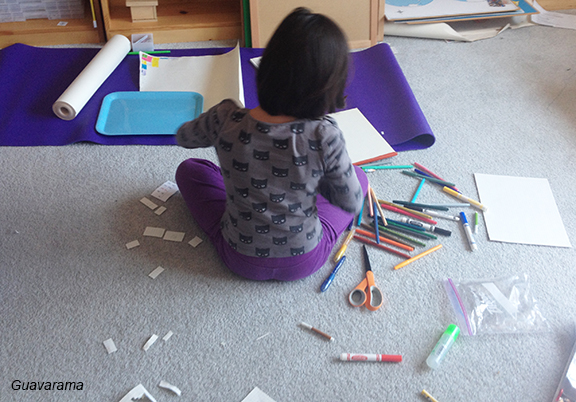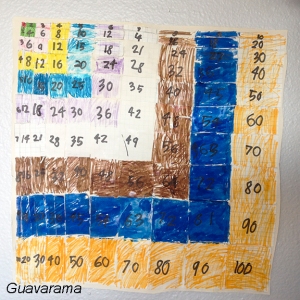Age: 7.75
Date: June 2, 2015
Presentation: Numerical Decanomial with Paper Rectangles and Squares
After the Decanomial layout we did last week (or was it the week before? The days blur…), Thumper is doing the numerical layout this week.
You can watch a video of how it’s done on youtube:
You’re basically doing the decanomial layout using paper. Now, when I was making my Cultivating Dharma album, I got confused by the writeup because it was not very clear. I had to cross reference with the video and other write-ups to come up with my current version. In the video, you will see that the papers are all the same size. But after doing some research I thought using graph paper and having sizes that are equivalent to their actual multiplication size (1×1, …10×10) is better.
You have 10 envelopes, on the outside labeled Decanomial 1, 2, 3, etc and one labeled Squares 1-10. On the inside, you have two sets of numbers for each decanomial:
- Decanomial 1: 2, 3, 4, 5, 6, 7, 8, 9, 10
- Decanomial 2: 6, 8, 10, 12, 14, 16, 18, 20
- Decanomial 3: 12, 15, 18, 21, 24, 27, 30
- etc.
Basically it has the numbers for that decanomial, assuming you haven’t used it already in the previous one. For example, decanomial 1 is 1×1, 1×2, 1×3, etc. “Decanomial 2” is 2×1, 2×2, 2×3, 2×4, etc. But since 2×1=2 was already in decanomial 1, and 2×2=4 is in the “Squares 1-10” envelope, you don’t need to include these.
In the write up, you have the child lay out diagonally the squares 1-10 first, then you build Decanomial 1, 2, 3, etc. You can talk about the multiplication table, to pick up the tickets in random and place them etc.
What We Did
Given how old Thumper is, and my own laziness, I really did not follow the presentation. I basically showed her my write up and said, we’re making this table, which is a paper representation of the bead layout you did last week. I showed her how you would mark off squares and rectangles on the graph paper and cut them out; reminded he she needed to write the value of the rectangle on the paper; that she does NOT have to mark and cut in order. She could very well do 1×1, 1×2, 2×1, 1×3, 3×1, etc. I know she knows half of her multiplication table so there is no need for order for us as part of learning process. I also told her she would glue these rectangles on our Ikea roll.

And Thumper being Thumper, off she goes with it herself. She had wanted to color the squares so I told her she could do it by coloring using the original multiplication table layout or the adjusted decanomial layout. I have observed that she does very well whenever work is a project that involves art and making things. At one point, she thought she had made a mistake and was fixing her mistake by cutting up little pieces of graph paper and gluing them together to get the desired rectangle size. I pointed out she could have very well just redrawn her rectangle and cut (bad teacher). But she was adamant about just doing it this way. I use this as an example that I don’t have to worry she doesn’t know how to finish the work.

Lest anyone thinks we’re operating a true Montessori classroom, here’s her super messy workspace. In Montessori, you’re supposed to work on a defined space, with things ideally organized. Obviously not happening here. Recently it occurred to me that I read an article once that some people need a messy desk to work. I wonder if it applies to my kid or if she’s just picked up my bad habits.
As a bonus, she is indirectly just gluing rectangles in semi random order, or rather, in the order she desires, as the write up aims to do. I really really like how we’re approaching this work. It feels more organic than following instructions from a write up.
Tada, the finished product. Took her a week of my nap time. She would spend about 1.5 hours while I nap to work on this before gets tired. A good chunk of time for concentrating on work.

